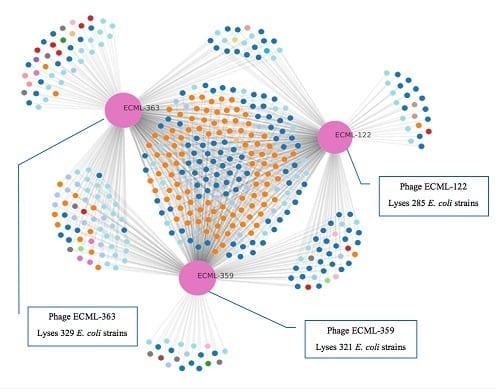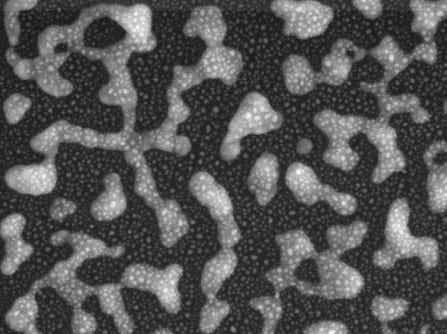
Researchers from the University of Copenhagen have succeeded in targeting and killing a single bacterial species (E. coli) without causing harm to the surrounding community of commensal bacteria in a simulated small intestinal microbiome using a cocktail of viruses (bacteriophages). The study proved that this approach is as effective in killing the targeted E. coli as broad-spectrum antibiotics but has much gentler impact on the normal, and often beneficial, microflora compared to antibiotics.
The experiment underlines the potential of using bacteriophages for target-specific manipulation of complex microbial communities and potentially replacing or supplementing usage of antibiotics as therapeutic agent against bacterial diseases.
Imagine that you have become ill because you have eaten some food that contained pathogenic bacteria. You keep running to the toilet and you may also throw up. You go to the doctor and are prescribed broad-spectrum antibiotics, which – in addition to killing the bad bacteria in your intestinal flora – carpet bomb the complex community of commensal bacteria forming a healthy intestinal flora.
New research from the Department of Food Science (FOOD) at the University of Copenhagen suggests that, in the not-too-distant future, it might be possible to drink a cocktail of selective viruses (bacteriophages) that travel directly into the gut and kill the disease-causing bacteria, so you get better – without the use of antibiotics and without harming the beneficial commensal intestinal bacteria.
The researchers have come a step closer to this scenario.
“The research shows that we have an opportunity to kill specific bacteria without collateral damage to the other, and otherwise healthy, intestinal flora”, says Professor Dennis Sandris Nielsen from Department of Food Science at the University of Copenhagen.
He emphasizes that the result was created in a model of the small intestine; so the next step will be to test the study on mice and later on humans if such treatment is to be implemented.
Model of the small intestine
The model in which the research has been conducted, TSI, was developed at FOOD by postdoc Tomasz Cieplak, in connection with his PhD project, with Professor Dennis Sandris Nielsen as his supervisor.

3D representation of the TSI in vitro model. TSI consists of 5 elements: main unit, water bath, syringe pump station, nitrogen tank and computer which controls the whole setup. In the main unit, there are multiple reactors capable to test up to 5 samples at the same time. Illustration: Maja Czesnik
“The novelty of the TSI model is that it simulates the presence of the small intestinal microbiota, which has largely been overlooked in other models of the small intestine. Other models existing on the market simulate only the purely biophysical processes, such as bile salts and digestive enzymes or pH, but here we included this important aspect of human gut physiology to mimic the small intestine more closely”, says Cieplak.
The composition of the intestinal flora in the model is representative of how the intestinal flora could look in a healthy person. In the study, researchers have added E. coli bacteria to the intestinal flora, which they then attempted to kill by utilizing a targeted cocktail of viruses (bacteriophages) developed by the company Intralytix.
New research in an old method

Professor at the Department of Food Science at the University of Copenhagen Dennis Sandris Nielsen.
“Using bacteriophages to kill pathogenic bacteria is not new and has actually been used to treat food-borne illnesses and other diseases in Eastern Europe for almost a century, but it was not until relatively recently that this approach started to attract more widespread research interest”, says Dennis Sandris Nielsen
The research into combating infectious diseases with viruses was not as interesting because you already had an effective treatment with antibiotics.
“It is different today, where resistance to antibiotics is an increasing problem in modern medicine. At the same time, we have become more aware of how important the commensal bacteria in the gut are for our health”, says Nielsen.
Phages (bacteriophages) are viruses that attack bacteria – in this context, bacteria in our intestinal microbiome. The classic lytic phage attacks bacteria by attaching to the surface of the bacterium and injecting its genetic material into the bacterium. It takes over the bacterium’s metabolism and redirects it to create new viruses. The bacterial cell, now taken over by the phage, will explode and send a lot of new phages into the surrounding area, which can then attack new bacteria.
Postdoc at FOOD Tomasz Cieplak about the research and the TSI:
The Latest on: Bacteriophages
[google_news title=”” keyword=”bacteriophages” num_posts=”10″ blurb_length=”0″ show_thumb=”left”]
via Google News
The Latest on: Bacteriophages
- Smart Money Is Betting Big In VRTX Optionson May 6, 2024 at 9:16 am
Investors with a lot of money to spend have taken a bullish stance on Vertex Pharmaceuticals VRTX. And retail traders should know. We noticed this today when the trades showed up on publicly available ...
- Four Reasons Why Parent Entrepreneurs Should Consider Nootropic Supplementson April 17, 2024 at 4:55 am
Firstly, let’s explain what nootropics are. Often dubbed “smart drugs” or “cognitive enhancers,” nootropics come in various forms – both as natural extracts and lab-crafted supplements.
- Smart Drugson April 15, 2024 at 9:08 am
In this cinematic one-off POV documentary, we follow Nik Badminton on a journey down the rabbit hole into the world of smart drugs and cognitive enhancement techniques as he tries to better his ...
- Smart Drug Delivery Market Soars with 14.9% CAGR Predictionon April 10, 2024 at 5:00 pm
According to a recent report by Market.us, the Global Smart Drug Delivery System Market size is expected to be worth around USD 32.5 Billion by 2032 from USD 9.7 Billion in 2023, growing at a CAGR of ...
- The dark side of medications: These drugs do more harm than goodon April 3, 2024 at 6:52 am
One such method is the use of ADHD drugs, commonly prescribed for attention deficit hyperactivity disorder. These “smart” drugs are believed to enhance focus and cognitive abilities.
- Can a Pill Make You Smarter?on March 27, 2023 at 7:31 am
Hausman hastens to add that his company has no interest in developing Phenserine as a "smart drug," for use in normal people. "I don't know if the FDA would ever allow a normal memory drug," he says.
- Modalert vs. Modvigil vs. Waklert vs. Artvigil: Detailed Reviewon January 8, 2021 at 8:07 am
In 2018, the smart drug market was valued at around $1.96 billion. However, it is expected to increase by a staggering 13.2% per annum and reach $5.32 billion by 2026. The fact of the matter is ...
- Smart Drugson August 6, 2020 at 12:54 pm
He takes smart drugs, tries fasting, and tests out the latest trends, but can his body keep up? Unfortunately Smart Drugs isn't available to watch right now. Add it to your list and we'll let you ...
- A beginner’s guide to using ‘smart drugs’on May 8, 2019 at 7:11 am
Before you take any particular drug or dietary supplement, you should consult with a doctor and do thorough independent research. Who should not be experimenting with smart drugs? MM: Anyone with ...
via Bing News










